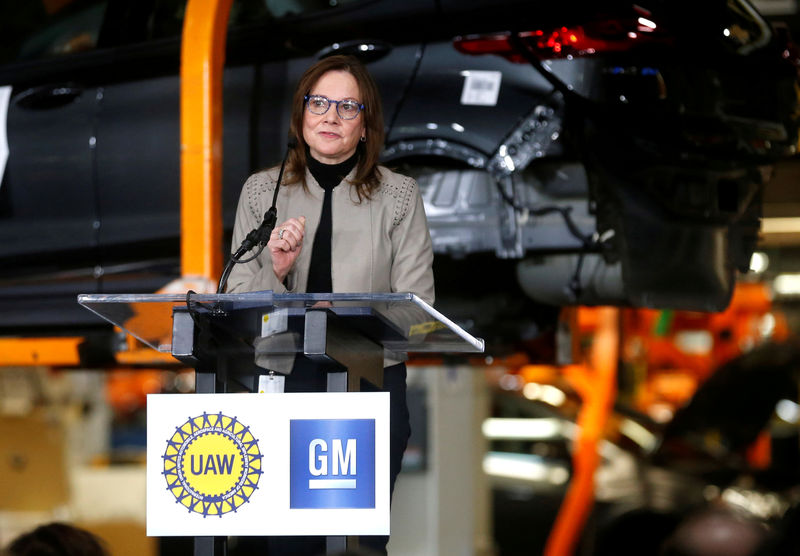By Ankit Ajmera and Rachit Vats
(Reuters) - General Motors Co's (N:GM) U.S. workforce productivity has declined since the automaker recovered from a 2009 bankruptcy, even as its profit per employee has risen, a Reuters analysis shows.
Those trends point to some of the root causes of the United Auto Workers (UAW) strike that has shut down the automaker's U.S. manufacturing plants for 18 days, already costing the company about $100 million a day.
The No. 1 U.S. automaker wants to boost productivity to offset financial pressure from a slowing global economy and investments in electric vehicles. The UAW is focused on increasing the share of profit going to workers, and closing wage gaps between full-time and temporary employees in GM factories.
GM's unionized workers in the United States build some of the company's most profitable truck and sport utility vehicles.
GM does not publish direct measures of U.S. productivity. But the number of vehicles the Detroit automaker built in the United States per U.S. employee fell to about 19 in 2018, down 13.5% from the 2010 level.
The Reuters calculation is based on GM annual production numbers sourced from research firm Wards Intelligence and the U.S. employee count in GM's annual filings.
A GM spokesman declined to comment on the analysis, saying that the automaker was "focused on negotiating a new labor agreement that builds a stronger future for the company and our workers."
The UAW said it believes GM's productivity is better since 2010 and the data would be more accurate based on total hours worked rather than employment.
Between 2010 and 2018 GM's estimated U.S. profit per employee surged 40% to about $94,097 last year, based on analysts' assumptions that U.S. operations generate about 90% of the automaker's North American operating profit disclosed in GM filings.
Click here for an interactive graphic: https://tmsnrt.rs/2p5MGjW
However, productivity and operating profit per worker have both slipped at GM between 2017 and 2018.
A broader measure of productivity in the U.S. auto sector shows declining productivity starting in 2013, according to data published by the Center for Automotive Research, an Ann Arbor, Michigan, industry research group.
One possible reason for the broad productivity declines at manufacturers including GM is the increasing complexity of vehicles and the federally mandated items, which result in more work elements, industry experts say.
Increasing production of large pickup trucks and SUVs is another factor causing potential productivity declines.
"The mix change to SUVs and pickups requires more work," said Ron Harbour, senior vice president for global automotive manufacturing at consulting firm Oliver Wyman. "Pickups for example are the most complex vehicles to build these days."
GM's U.S. vehicle production increased 15.5% to about 1.99 million vehicles in 2018, compared with the 2010 level. GM's U.S. hourly employment remained largely stable or fell slightly during that period, while the number of U.S. salaried jobs rose and eventually exceeded hourly workers.
The company's salaried hiring was part of a recovery from bankruptcy, as it added a finance arm and information technology staff.
GM's salaried employees - engineers, accountants, HR managers, marketers and other staff - nearly doubled to 53,000 in 2018 from 2010, lifting overall U.S. worker numbers by 34% to 103,000 last year.
NORTH AMERICAN JOB CUTS
Last November, GM Chief Executive Mary Barra ordered 15,000 jobs cut from GM's North American workforce to boost profitability at a time when the company is spending billions to develop next-generation technologies.
GM also said at the time that five North American factories had no future product assignments and could be shut down, including car assembly plants in Lordstown, Ohio; Detroit-Hamtramck, and Oshawa, Ontario.
"These are things we are doing to strengthen our core business," Barra said in November. "We are right-sizing capacity for the realities of the marketplace."
GM argues the plant shutdowns are necessary responses to market shifts, and that UAW wages and benefits are $13 an hour higher than competing nonunion auto plants in southern U.S. states.
UAW said hourly labor costs equate to just 5% to 6% of the price of a vehicle.
Reuters arrived at the productivity figures by looking at GM's annual U.S. vehicle production as reported by Wards Intelligence and adjusted earnings before interest and taxes from the automaker's annual reports, and dividing those by GM's total U.S. salaried and hourly employees combined.
However, when GM's U.S. salaried employees, which include workers not directly involved in the manufacturing process, are left out of the equation, the company's productivity per employee rose between 2010 and 2016, while slightly dipping year-over-year in 2017 and 2018.

Click here for an interactive graphic: https://tmsnrt.rs/2ADSh3B